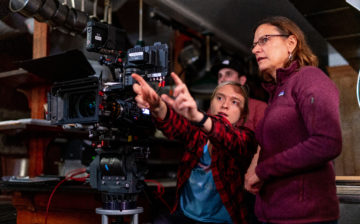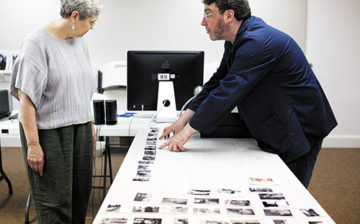Blog
MFA Admissions Advice
MFA Admissions Advice
The low-residency program at MMC is for artists interested in engaging in a rigorous educational experience leading to the MFA degree in the media arts fields of photography, filmmaking and multimedia. The College seeks those who are motivated to produce high-quality creative work under the guidance of experienced mentors and eager to participate in a community of artists striving for artistic growth through individualized practice and study. The MFA at Maine Media College offers an intimate, vibrant and intense community sensitive to the creative needs and goals of each student.
The MFA Committee holds that the program flourishes by attracting and enrolling a student body with a broad array of interests, diversity of experiences and wide-ranging educational backgrounds. This approach to admissions makes for a rich environment in which to make, think, and talk about art. Therefore, the Committee makes no specific requirements with regard to undergraduate majors nor does it specify a minimum number of undergraduate credits in art or art-related disciplines.
MFA Committee members review completed applications (all application materials) as they are received and render opinions regarding admissions to the MFA Steering Committee. MFA admissions materials are reviewed with regard to evidence of a prospective student’s unique visual statement, cohesiveness of voice, and competency in their chosen medium, as well as their level of understanding of their work and their potential to succeed in a low-residency program. Not only are an applicant’s qualifications and preparedness to pursue the low-residency MFA degree considered, the faculty also takes into account the population of current students and strives to admit students who add diversity and breadth of experience to the body.
The MFA Committee bases its judgments on materials applicants are required to submit: portfolio, reel, or other documentation of work; essay; transcripts; resume; three letters of recommendation; and interviews with applicants. What follows is a discussion of these elements of the application packet and the ways in which Committee members consider them. Generally speaking, they are presented in the order of priority that reflects their significance in admissions decisions.
- Documentation of Work: The MFA is a Fine Arts degree. The Committee would prefer to see recent work that makes a coherent statement representative of your creative focus and unique “voice.” Therefore, it is not a good idea to submit work done commercially over which you did not have exclusive creative control, nor is it recommended that you send work with the sole intention of demonstrating your versatility or technical virtuosity. Submit work that most clearly identifies your personal creative interests. The work should be technically strong enough to support the content of the work. This is to say that the Committee values technique primarily in relation to artistic statement.
- Applications in Photography: An applicant in photography should submit 20 – 25 images that represent a coherent body of creative or documentary work made within the past three years. This work is to clearly show the applicant’s personal artistic orientation, fundamental areas of concern (especially in the case of documentary forms) as well as the working processes significant to the applicant’s practice. In instances where the applicant is developing a project incomplete at the time of application, the applicant may submit this work to supplement the primary portfolio if they believe it represents a significant change in either statement or process. The applicant should include a brief statement (in addition to the required essay) explaining how the work departs from that submitted as the portfolio. Additional professional or contract work is reviewed, but is of secondary importance.
- Applications in Film: Applicants working in film production should submit a video or videos representing personal creative work made within the past three years. Running time for all materials together shall not exceed 30 minutes. Those most interested in screenwriting should submit a portfolio of written work that includes the following: 1) a concept for a feature script or a documentary that you might find it interesting to develop (no more than one typed page); and 2) a short screenplay of no more than 15 pages or two scenes in screenplay format. If the latter option is chosen, one scene should provoke the reader’s curiosity and engagement via visual storytelling and an absolute minimum of dialogue (no more than four pages); the other scene should be driven by dialogue and character development (no more than seven pages). Each scene should compel the reader to want to follow the character into a more developed story. Additional professional or contract work is reviewed, but is of secondary importance. Professional work should be labeled as such. All material presented must indicate the creative role of the applicant. Serving “below the line” on a project is not acceptable for application material. Writers may submit scripts as well as other writing samples. A multimedia applicant may submit a URL for web-based work.
- Applications in Multimedia: An applicant in multimedia should submit material representing personal creative work made within the past three years. If an applicant engages more than one medium, either in combination (installation, performance, books) or as discrete components of ongoing artistic practice, they should submit photographic or time-based documentation of these works as well as a brief written description of the project. Such time-based documentation should not exceed 30 minutes in duration. Still photographic documentation for all projects represented should not exceed 25 images. Those submitting documentation of books may separately include excerpts of writing in .doc or .pdf form. Such samples shall not exceed ten pages, total. A multimedia applicant may also submit a URL for web-based work. Additional professional or contract work is reviewed, but is of secondary importance. Professional work should be labeled as such.
- Essay: Your essay should be approximately 500 words in length, describing your background and formative influences. Include information that you deem especially relevant to your artistic evolution and the development of content in your work. This means that you ought to consider contexts, artistic or otherwise, in which your work might be discussed, particularly if you have experiential or educational background in these areas. For example, if your work is involved with areas of thought outside of the arts (psychology, sociology, anthropology, science, etc.) this is information the Committee would appreciate. As best you can, please connect this information to the work you submit with your application. We would also like to know your reasons for pursuing an MFA degree as well as your current and longer-term goals. These might be practical or artistic, or both.
- Letters of recommendation: The Committee accepts letters from academic and/or professional colleagues. Compelling letters from arts practitioners and teachers who are well known to Maine Media College can be persuasive, especially if you have worked or would consider working with these individuals as mentors. If this is not the case, the next item, your resume, may be more informative. Letters writers should attest to your talents, commitment and cognitive abilities, or other personal qualities that would have bearing upon your involvement in the MFA program.
- Resume: This should be an artist’s resume including your educational background and degrees earned (whether or not these degrees are in the fine arts) as well as your professional activities (only if they are art-related). Information regarding professional activities is typically categorized along the following lines: Exhibitions, Screenings, and Publications; Awards and Grants; Bibliography (reviews or other critical discussion of your work. If you have worked commercially in the arts, this information is relevant. If this work has been done in collaboration with others, please indicate your creative role in each item listed. If you have been employed as an educator or administrator in an arts-related capacity, this information is also relevant.
- Transcripts: Transcripts serve as documentation of degrees earned and areas of study pursued. They are also helpful to program administrators in understanding the educational backgrounds of applicants and eventual students. GPAs or grades earned for specific courses are of less significance to the Committee in making admissions decisions.




